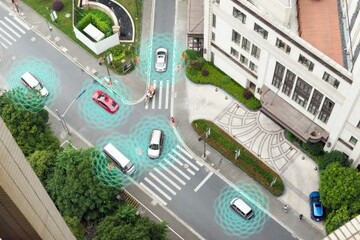Draper’s New Driver Assist Tech Can ‘See’ Pedestrians
CAMBRIDGE, MA—Draper today unveiled its newest addition to the company’s extensive portfolio of automotive capabilities with the new PathScout system. PathScout aims to address the complexity of pedestrian protection systems by equipping drivers with a system that alerts them to nearby pedestrians when it detects GPS signals emitted by their mobile phones.
PathScout adds a new kind of data to the advanced driver-assistance systems that augment many vehicles’ onboard sensors and intelligence. PathScout can detect the location and predict the path of a person using a cell phone who may not be in the line of sight of a human driver or various perception sensors including cameras, RADAR and LiDAR. In this way, PathScout can warn drivers of a potential collision between their vehicle and vulnerable road users based on cell phone signals.
Sabrina Mansur, automotive business manager at Draper, said, “Imagine a car that can interpret pedestrian and vehicle traffic based on smartphone GPS location signals. That’s what PathScout can do. We believe ‘vehicle to everything’ (V2X) is emerging as an important capability in the development of advanced driver-assistance systems.”
Pedestrian protection systems like PathScout are new entrants in the field of Advanced Driver Assistance Systems. ADAS technologies are designed to work together to automate and enhance vehicle safety by alerting the driver to potential problems and avoid collisions. Adaptive cruise control and collision avoidance systems are two examples.
Common approaches to pedestrian protection systems rely on sensing images of the visible spectrum or capturing thermal infrared images of pedestrians, cyclists and other vehicles. PathScout augments these approaches by using easily detectable and anonymous cell phone GPS location and trajectory information to zero in on pedestrian and vehicle traffic.
Draper recently earned a patent for the technologies underlying PathScout. The system can be configured to use cell tower signals, Wi-Fi signals and other location sensing devices and methods in addition to GPS data.
Troy Jones, technical director for automated driving systems at Draper, said, “Current sensors only see a limited view of the world in high density urban traffic. PathScout can predict if an individual’s path will cross the car’s path. PathScout fills the gaps in perception that come with relying solely on a driver’s vision.”
The new offering, which is available to license, adds to Draper’s growing portfolio of autonomous system and self-driving car capabilities. The portfolio includes the Draper APEX Gyroscope—a MEMS gyroscope that provides centimeter-level localization accuracy; Draper’s all-weather LiDAR technology, named Hemera, a detection capability that’s designed to see through dense fog and is compatible with most LiDAR systems; and a high-resolution solid-state LiDAR with MEMS beamsteering technology for autonomous vehicles.
Released September 23, 2020

